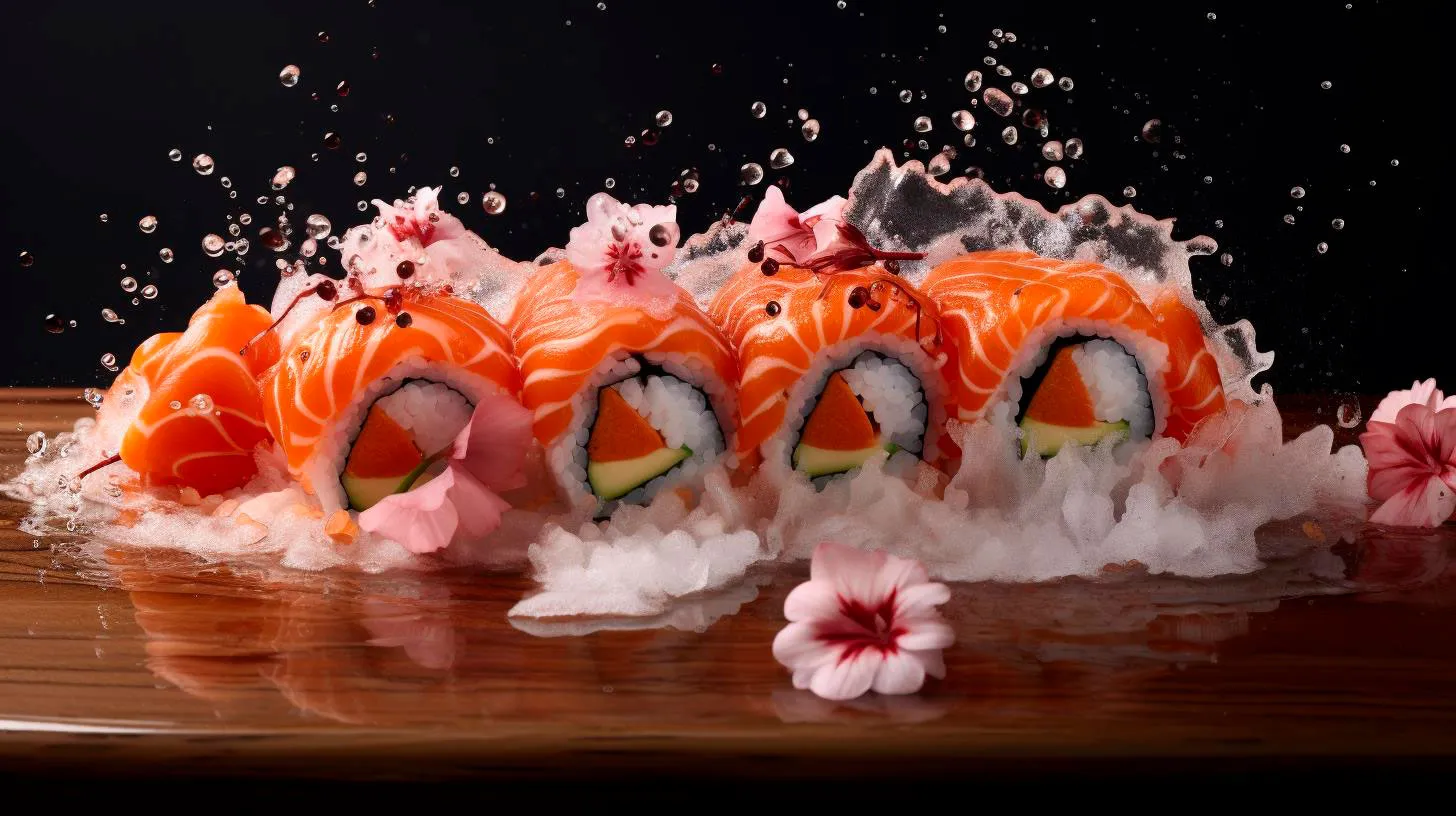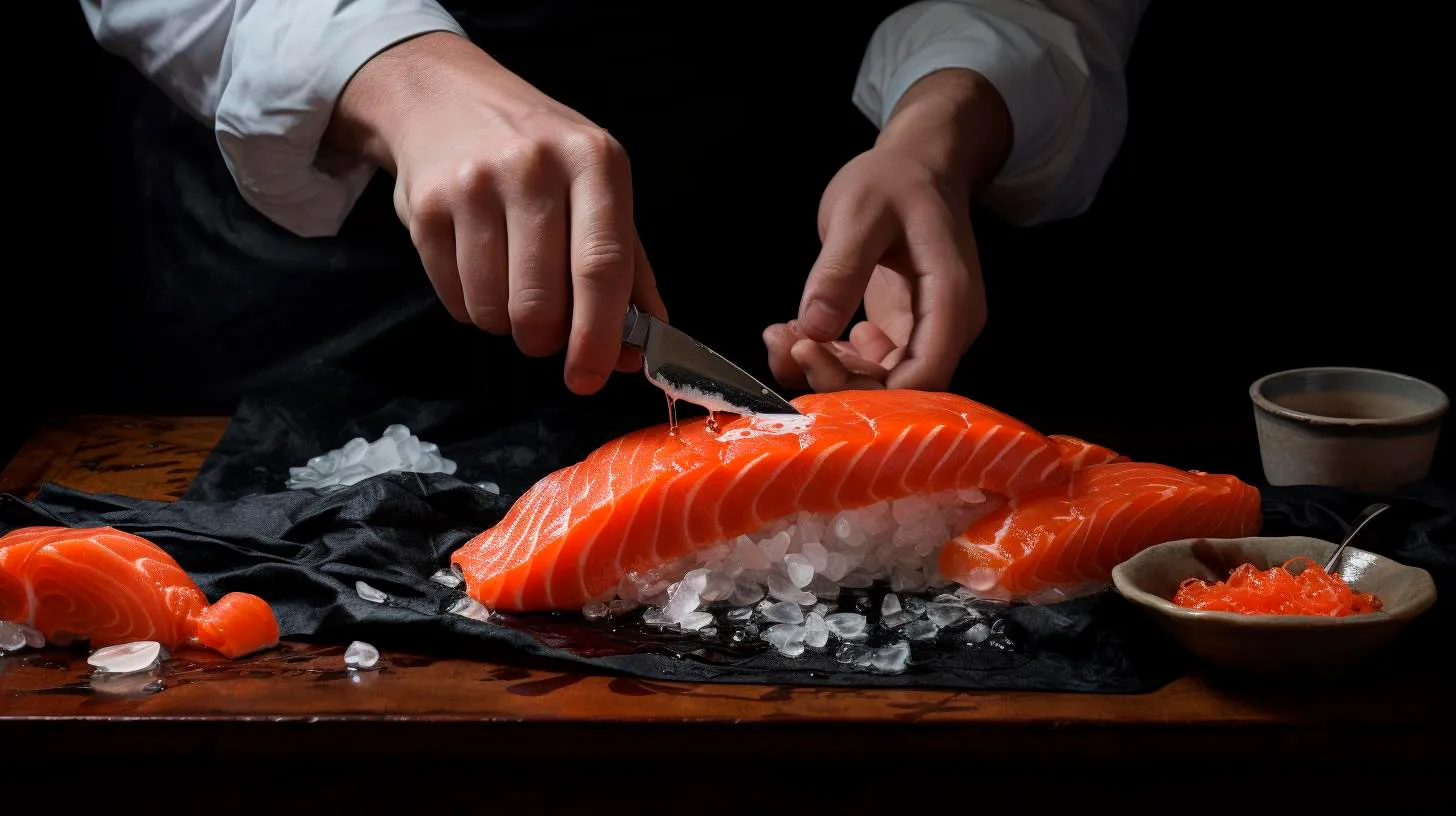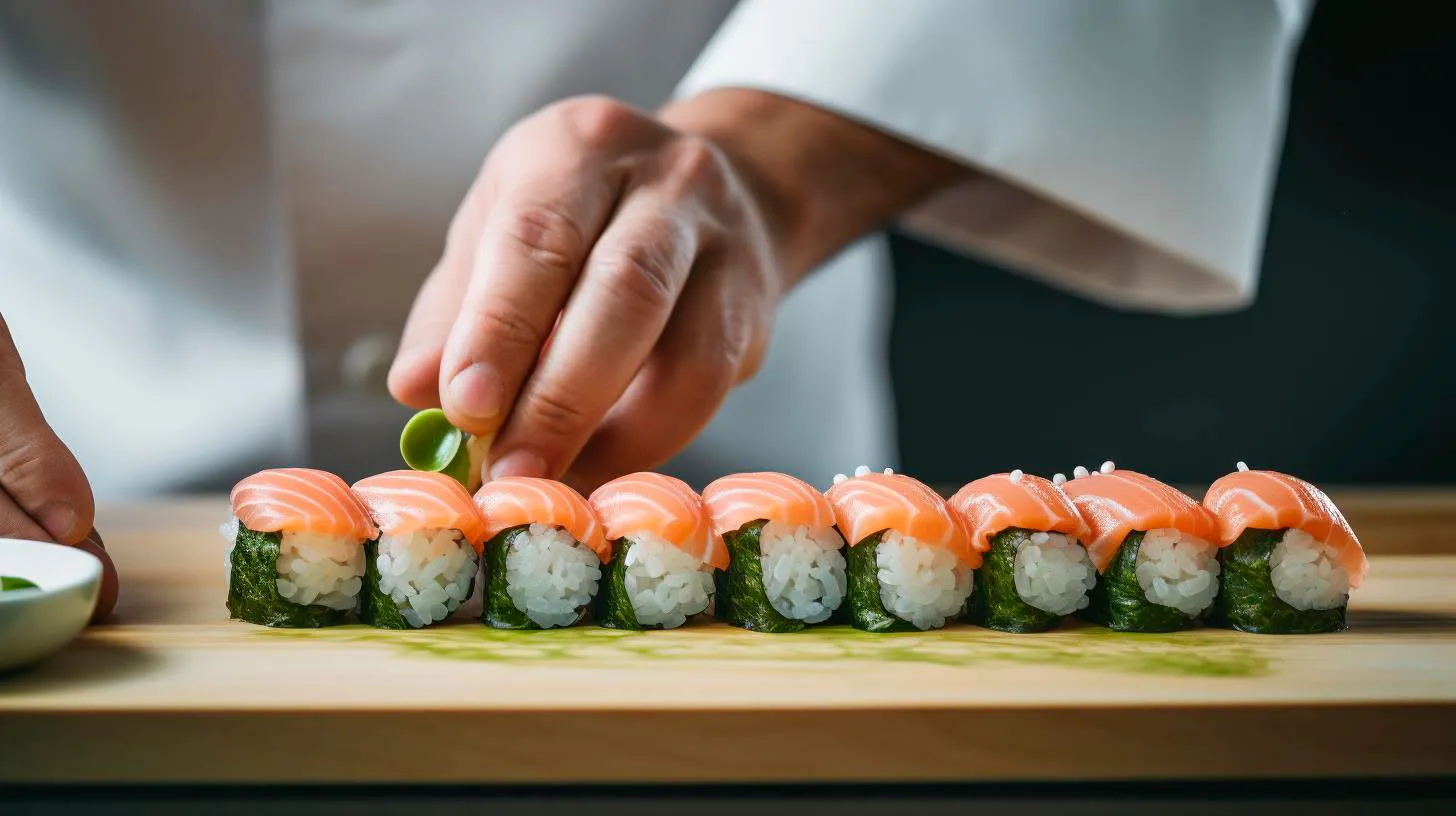The Art of Sushi Making and Its Deep Connection to Samurai Philosophy
In this article, we will explore how the art of sushi making reflects the principles of Bushido and the way of the samurai.
The Way of the Samurai
The samurai, members of the Japanese military nobility, adhered to a strict code of ethics known as Bushido. This code emphasized honor, loyalty, self-discipline, and mastery of various skills, including martial arts. Samurai were expected to live by these principles and embody the spirit of the warrior throughout all aspects of their lives.
Sushi making, like the way of the samurai, demands precision, discipline, and a commitment to excellence. From selecting the freshest ingredients to mastering the intricate art of knife skills, every step in the sushi-making process requires a meticulous approach.
Let’s dig deeper into the connection between sushi making and samurai philosophy:
Mastery through Discipline
Just as samurai dedicated their lives to mastering the sword, sushi chefs undergo rigorous training to perfect their craft. In Japan, it is not uncommon for aspiring sushi chefs to apprentice for years before they are allowed to prepare sushi on their own. This intense training instills a sense of discipline, precision, and attention to detail.
Key Takeaways:
- Sushi chefs undergo years of apprenticeship to perfect their craft.
- Mastery requires discipline, precision, and attention to detail.
- The pursuit of perfection is a continuous journey.
Respect for Ingredients
One of the fundamental principles of samurai philosophy is respecting one’s surroundings. This reverence for the environment extends to the ingredients used in sushi making. Sushi chefs carefully source their ingredients, prioritizing freshness and quality. This respect for ingredients is not only a reflection of the samurai’s connection to nature but also crucial for delivering exceptional flavors in sushi.
Key Takeaways:
- Freshness and quality of ingredients are crucial for sushi making.
- Respecting the ingredients reflects the samurai’s connection to nature.
- Delivering exceptional flavors requires a deep understanding of ingredients.
The Art of Knife Skills
Samurai were renowned for their expertise in swordsmanship, and their ability to wield a katana with precision was seen as an art form. Similarly, sushi chefs must master the art of knife skills. With a single stroke, they slice through delicate fish and ingredients, showcasing their mastery and finesse.
Key Takeaways:
- Sushi chefs must master the art of knife skills.
- Precision and finesse are crucial for slicing delicate ingredients.
- Knife skills are a visible representation of the chef’s craft.
Presentation and Aesthetics
Another aspect that connects sushi making to samurai philosophy is the emphasis on presentation and aesthetics. Just as samurai took great care in adorning themselves with beautiful armor and clothing, sushi chefs meticulously arrange each piece of sushi to create visually stunning presentations. The artistry involved in sushi making goes beyond taste; it is a feast for the eyes as well.
Key Takeaways:
- Sushi chefs prioritize the visual appeal of their creations.
- The artistry of sushi making extends beyond taste.
- Beautiful presentation enhances the overall dining experience.
The Importance of Continuous Improvement
Samurai believed in constant self-improvement and never becoming complacent. This mindset of continuous improvement is deeply ingrained in sushi making as well. Sushi chefs are constantly seeking ways to enhance their skills, experimenting with new ingredients, and refining traditional techniques. This pursuit of perfection ensures that sushi evolves, captivating diners with innovative flavors and creative twists.
Key Takeaways:
- Continuous improvement is essential in both samurai philosophy and sushi making.
- Exploring new techniques and experimenting with flavors leads to innovation.
- Sushi is an ever-evolving culinary art.
In Conclusion
Sushi making is more than just assembling ingredients; it is an art form deeply connected to the traditions and values of samurai philosophy. The discipline, precision, respect for ingredients, knife skills, presentation, and pursuit of continuous improvement reflect the essence of Bushido. Embracing the way of the samurai, sushi chefs pay homage to the rich history and culture that shapes their craft. So, the next time you savor a piece of sushi, take a moment to appreciate the profound connection between this delectable cuisine and the noble spirit of the samurai.
Preserving Traditions: How Sushi Reflects the Spirit of the Samurai
In this article, we delve into the world of sushi and explore how this iconic dish embodies the essence of the samurai way of life.
The Art of Sushi-Making
Sushi is a culinary delight that often springs to mind when thinking about Japan. It is a dish that requires precision, patience, and a deep understanding of the ingredients. Just like the samurai meticulously honed their sword skills, sushi chefs dedicate years to perfecting their craft.
Key Takeaways:
- Sushi-making emphasizes the importance of precision and attention to detail.
- Patience is essential in achieving the perfect balance of flavors in sushi.
- Sushi chefs undergo rigorous training and apprenticeships, akin to the samurai’s commitment to mastering their skills.
The Principle of Simplicity
The samurai believed in simplicity and minimalism, and this philosophy is mirrored in the art of sushi-making. Sushi often showcases just a few key ingredients, allowing each one to shine in its own right. The focus is on the quality of the ingredients rather than complex flavor combinations.
Key Takeaways:
- Sushi embodies the idea that less is more, with each ingredient carefully selected for its unique qualities.
- The simplicity of sushi highlights the importance of quality ingredients and their natural flavors.
- Sushi teaches us the value of restraint and appreciating the beauty of simplicity.
Mastery Through Practice
Like the samurai who devoted their lives to continuous improvement, sushi chefs dedicate themselves to honing their skills through years of practice. From perfectly cooking the rice to mastering the art of slicing fish, becoming a skilled sushi chef requires discipline and unwavering commitment.
Key Takeaways:
- The mastery of sushi-making comes from countless hours of practice and refinement.
- Sushi chefs strive for perfection in every aspect of their craft, just as the samurai sought perfection in their swordsmanship.
- Consistency and excellence are the hallmarks of both sushi-making and the samurai code.
Respect for Nature
The samurai revered nature and saw themselves as guardians of the land. Similarly, sushi-making pays homage to the natural world and its abundance. From the freshest fish to seasonal vegetables, sushi celebrates the harmony between humans and nature.
Key Takeaways:
- Sushi encourages the use of locally sourced ingredients, promoting sustainability and respect for the environment.
- Traditional sushi-making focuses on preserving the natural flavors of the ingredients, without overpowering them.
- Just as the samurai took care of the land, sushi chefs prioritize the responsible sourcing of ingredients.
Adaptation and Innovation
While sushi holds deep roots in tradition, it has also adapted to modern tastes and preferences. In the same way that the samurai adapted to changing times, sushi has evolved to cater to a wider audience. From creative fusion rolls to vegetarian options, sushi continues to reinvent itself while staying true to its core principles.
Key Takeaways:
- The versatility of sushi allows for innovation and creative exploration while preserving the essence of the dish.
- Sushi’s adaptation to different dietary preferences and tastes demonstrates its ability to remain relevant in the ever-changing culinary landscape.
- The samurai spirit lives on through sushi’s ability to adapt and embrace new influences.
Preserving the Past, Embracing the Future
Sushi is not just a meal; it represents a connection to our cultural heritage and the spirit of the samurai. By embracing the traditions of sushi-making, we honor the values of discipline, simplicity, and respect for nature. As we indulge in this exquisite delicacy, let us remember the samurai’s unwavering commitment to mastery and their timeless lessons that resonate through the art of sushi-making.
Samurai-Inspired Sushi Exploring the Symbolism Behind Each Roll
Join us on this culinary journey as we unravel the secrets behind every roll.
The Art of Samurai-Inspired Sushi
Samurai-inspired sushi goes beyond just a delicious meal—it embodies the spirit of the ancient warrior class of Japan. Just like samurais excelled in their martial arts, these sushi rolls are crafted with utmost precision, reflecting the discipline and attention to detail of the samurai tradition. Each roll is meticulously handcrafted by skilled sushi chefs who have mastered the art of balance and presentation.
When it comes to the visual aspect of samurai-inspired sushi, the colors and arrangement mimic the elements found in traditional samurai armor. The vibrant hues of the ingredients bring life to the plate, while the careful arrangement of each piece reflects the meticulousness of samurai battle formations on the battlefield.
Beyond the visual symbolism, the flavors and ingredients behind each samurai-inspired sushi roll also have their own unique significance. Here are some noteworthy rolls and their key takeaways:
1. Dragon Roll
- Symbolism: The dragon has long been associated with power, strength, and good fortune in Japanese culture. The Dragon Roll embodies these qualities by combining spicy tuna and avocado, rolled in sushi rice and topped with vibrant slices of unagi (eel).
- Key Takeaways:
- Indulge in a combination of spicy and savory flavors.
- Experience the rich and buttery texture of unagi.
- Embrace the auspicious symbolism of the dragon in Japanese culture.
2. Sakura Roll
- Symbolism: The Sakura Roll pays homage to the iconic cherry blossoms that bloom across Japan in spring, symbolizing beauty and the transient nature of life. This roll typically features delicate pink soy paper wrapped around fresh sashimi and sushi rice, with a touch of wasabi for an added kick.
- Key Takeaways:
- Enjoy the freshness and vibrancy of various sashimi.
- Experience the perfect balance of flavors with a hint of wasabi.
- Appreciate the ephemeral beauty represented by cherry blossoms.
3. Koi Roll
- Symbolism: In Japanese culture, koi fish are a symbol of determination, perseverance, and success. The Koi Roll captures their essence by combining tempura shrimp, avocado, and cucumber, topped with colorful slices of fish to depict the vibrant patterns found on koi fish.
- Key Takeaways:
- Experience the satisfying crunch of tempura shrimp.
- Savor the freshness and variety of fish toppings.
- Find inspiration in the symbolism of determination and success depicted by koi fish.
Samurai-Inspired Sushi: A Gastronomic Journey
Aside from the symbolism, samurai-inspired sushi offers an extraordinary gastronomic journey. Each bite is a harmonious blend of flavors and textures carefully crafted to tantalize your taste buds. From the umami-packed soy sauce to the delicate balance of sweet and tangy pickled ginger, every element on your plate adds to the overall culinary experience.
Samurai-inspired sushi not only delights your palate but also encourages you to appreciate the cultural heritage it represents. It is a fusion of history, art, and culinary excellence that offers a truly immersive dining experience.
Celebrate Tradition with Samurai-Inspired Sushi
Next time you find yourself craving sushi, consider delving into the world of samurai-inspired rolls. Whether you’re a history enthusiast, a sushi aficionado, or simply looking for a unique culinary adventure, samurai-inspired sushi offers a dining experience like no other.
Stay tuned for the latest samurai-inspired sushi creations in your local sushi restaurants and buckle up for a gastronomic journey through Japanese culture and symbolism!
A Taste of Honor: The Intersection of Sushi and Samurai Tradition
In this article, we embark on a culinary journey through Japan, exploring the fascinating connection between sushi and samurai culture.
Sushi: A Culinary Journey Through Japan
Sushi, a beloved Japanese cuisine, has gained immense popularity worldwide for its exquisite taste, presentation, and freshness. This delicacy traces its roots back to Ancient Japan, where it was initially created as a method of preserving fish by fermenting it with rice. Over time, sushi evolved to become the artful creation we admire today.
-
Artistry on a Plate
Sushi is much more than a simple roll of raw fish. It is a masterpiece meticulously crafted by skilled sushi chefs, known as Itamae. These chefs dedicate years to perfecting their craft, learning the art of selecting the best ingredients, precise knife cuts, and creating visually stunning arrangements.
-
Freshness Meets Flavor
One of the core principles of sushi-making is using only the freshest ingredients. The quality of fish and seafood used in sushi directly impacts its taste and texture. Sushi enthusiasts often look for establishments that source their ingredients from reputable suppliers, ensuring a memorable dining experience.
-
Variety and Innovation
Sushi offers an extensive range of options beyond traditional raw fish rolls. From delicate sashimi to vibrant vegetarian rolls, sushi caters to various palates and dietary preferences. With chefs constantly pushing the boundaries of creativity, you can find sushi infused with unique ingredients and flavors, providing a delightful fusion of tradition and innovation.
Samurai Culture: Honor, Tradition, and Craftsmanship
The samurai, revered warriors of feudal Japan, embody values of integrity, loyalty, and meticulous craftsmanship. Their influence can be seen not only in the battlefield but also in various aspects of Japanese culture, including the art of sushi-making.
-
The Way of the Samurai
Samurai culture, known as Bushido, emphasized the importance of discipline, respect, and honor. These principles are deeply ingrained in the philosophy of sushi-making, where chefs adhere to strict codes of conduct and meticulous attention to detail.
-
Knife Skills and Precision
Samurai were celebrated for their mastery of the sword, displaying impeccable precision and elegance in their movements. Similarly, sushi chefs wield their knives with skill and finesse, producing perfect cuts of fish and seafood. The level of precision required in both crafting sushi and wielding a sword highlights the shared dedication to craftsmanship.
-
An Aesthetic Approach
The aesthetic sensibilities of samurai culture and sushi-making are intertwined. From the presentation of sushi on carefully chosen ceramic plates to the use of edible garnishes, every element is carefully considered. Just as samurai adorned their armors and swords with intricate details, sushi chefs strive to create visually stunning plates that please both the eyes and the taste buds.
In conclusion, sushi and samurai culture are two pillars of Japanese heritage that beautifully intersect. Sushi reflects the culinary artistry and palate-pleasing experiences, while samurai tradition showcases the values of honor, tradition, and impeccable craftsmanship. Exploring the origins and intertwining principles of these two cultural icons enables us to appreciate the depth of Japan’s rich history.
Embark on your own gastronomic adventure and savor the taste of honor found in a beautifully crafted sushi roll. Experience the art of sushi-making and immerse yourself in the spirit of samurai culture.



